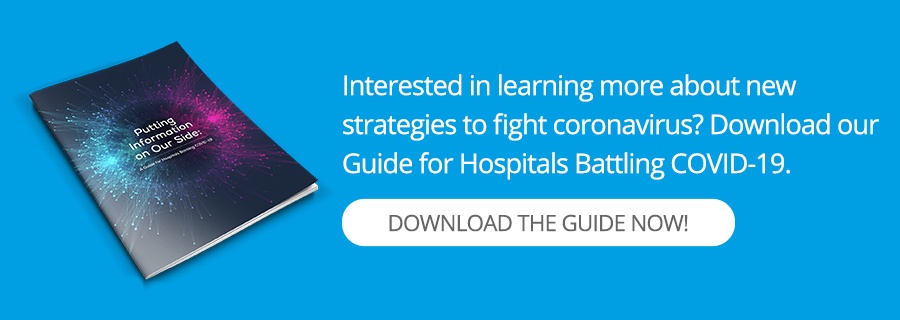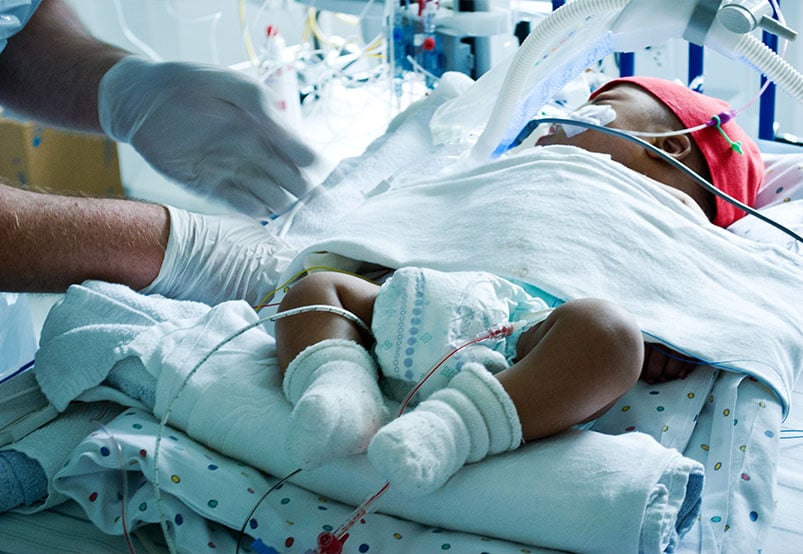
“COVID, overnight, has changed how consumers are going to access and engage health systems.” - Peter Kung
“Now, we’re being thrust into this mode where the operators need innovation and are pulling for it, rather than us pushing it.” - Daniel Durand, M.D.
“Technology is not a singular force that solves for one big problem, but rather an initiative that creates many solutions.” - Emma Fauss
“Healthcare is a welcome incubator for innovation, in sharing best practices with other organizations for the good of all patients.” - Michelle Stansbury
From learning faster than we ever have about microscopic viruses like SARS-CoV-2, to sending humans into space on commercial vehicles in a successful SpaceX launch, we live in a world of innovation.
In a recent World Congress webinar, “The Silver Lining of COVID-19: Accelerate Innovation on the Road to Transformation,” healthcare innovation experts discussed how the culture of innovation may be the biggest benefit from a pandemic that has changed the world dramatically in a few short months. Michelle Stansbury, vice president of IT innovation at Houston Methodist; Peter Kung, vice president and chief innovation officer from SCL Health in Colorado; Daniel J. Durand, M.D., chief innovation officer of LifeBridge Health in Baltimore; and Emma Fauss, Ph.D., CEO of Medical Informatics Corporation (MIC); brought forth insightful perspectives on how this pandemic is promoting innovation within the healthcare industry.
Their advice? Start now.
Engagement across the Continuum of Care is Changing
Healthcare is harnessing more opportunity than it ever has before to engage with patients and providers in unique ways, the panel explained.
“With the emergence of COVID, it’s made hospitals acutely look at different telehealth options out there, whether that’s external to the hospitals trying to connect physicians to patients, or [internally, as they] operationalize different remote workflows within the hospital,” Fauss said, talking about MIC’s experience enabling remote monitoring workflows and patient surveillance in hospitals across the country.
Pre-COVID-19, Houston Methodist, a multi-hospital system in the Texas Medical Center, was focused on innovation initiatives around consumerism and patient access. “We hadn’t seen wide adoption [of telehealth] yet, even though we were trying,” Stansbury noted. “Clinicians liked seeing patients face to face, but all of a sudden, COVID hit. What we’ve really seen is [innovation has] just exploded across our organization--not just from virtual visits from patients, but also with our virtual ICU,” she said.
Kung saw the same perspective shift at his facility, too. “COVID, overnight, has changed how consumers are going to access and engage health systems. One of the important roles of innovation is being able to put these things out there. So, when COVID did hit, if you have at least some foundation, you are able to build off that,” he said.
Dr. Durand noted that there were a few early adopters in his organization interested in telehealth, but that the overall subscribership was less than what consumers wanted. “Now, we’re being thrust into this mode where the operators need it,” he said. “It’s been wonderful from a change management perspective, because now they’re pulling for it. What I’m even more excited about is what comes next: I think folks will want more of it.”
Rather than thinking about bricks and mortar in place of virtual care, Dr. Durand and the other experts say that healthcare is considering the entirety of care that includes both in a seamless way. Experts say this is part of an explosion of innovation expected over the next five years, while Fauss emphasized that the proliferation could reach well past a digital front door into the back-end operations of a health system.
“We’ve all seen pressure put on innovation arms of institutions to think out of the box in regard to how we meet these immediate needs that have time pressures that haven’t been experienced in our living memory, to how to organize staff and resources, change workflows on the fly, etc. It’s shaken a lot of things up,” Fauss said, “but it hasn’t changed the core of what they do--deliver a high quality of care with the resources they have. It’s a focus on innovation, a focus on how to get things operational as fast as possible.”
Creating a Home for Innovation, and a Culture
Fauss also offered perspective about the role of technology as not a singular force that solves for one big problem, but rather an initiative that creates many solutions. “I look at it as something where you introduce the technology and, even if you’re under less-than-ideal situations in terms of how you do a massive roll-out, people can embrace it because they have an immediate need,” she said. “If it fills a gap, if you have a tool that drives value – and if it reduces a problem that existed before--people will continue to use it.” That, she explained, is how innovation continues to win fans who pull it along with them, rather than push against change.
A year and a half ago, Houston Methodist made the decision to create a dedicated space where technology could come alive and allow clinicians and others to see the possibilities. “We created a home of the future, a clinic of the future. We created a VR room to showcase this new technology to help clinicians see it real-time without having to install it as a pilot,” Michelle said. The hospital created an opportunity to get hands-on with technology before it’s deployed at scale to help the hospital find solutions that work best, and move them forward with clinician and leadership buy-in. “One of our hospitals started using MIC’s Sickbay platform in the virtual ICU. It’s been such a tremendous benefit for us that we’ve expanded it,” Stansbury added.
Kung noted that for the enterprise initiatives his team has undertaken, the key to success lies in the interoperability. “It’s not so much about invention,” he said. “It’s about seamless integration between these initiatives. We’re on that road to creating a digital front door to make it a frictionless and seamless experience. And now, the emphasis of accelerating that type of work is going to be needed.”
Dr. Durand and Emma Fauss both emphasized the importance of innovation not simply as a place or a department, but rather a mindset in which everyone participates, rather than just a designated few. “We should all want centralized innovation groups to be viewed as promoting innovation rather than stifling it and forcing it through some sort of central corridor,” Dr. Durand said.
“What’s important to distinguish is that an innovation mindset built into the organization infrastructure is not a natural thing right off the bat. There are usually innovative people and pockets, but to formalize an innovation mindset builds a structure within your organization to facilitate that innovation,” Fauss explained.
The “Holy Grail,” she said, is the opportunity to take what works for your institution and then operationalize it. “It is distinct from what you usually see in typical organizations,” she said. “That concept of building innovation as a core component is critical for people trying to build this in their own organization.”
Leveraging Data to Make Change
How and when to integrate telehealth and other virtual technologies into the healthcare space is something that can not only be measured with data, but can also serve as an opportunity to improve the business of providing care.
“What we were working on before COVID was operating our hospitals like a command center,” Kung said. “The value proposition was around access and quality. Now, if I say ‘command center,’ it’s that concept of asking, ‘How can you efficiently manage your hospital with innovation or transformation like a command center?” he said.
As technology makes advancements possible, it’s not an “either/or” scenario, Fauss explained. She cautioned against looking at telehealth as replacing in-person visits, for example, but rather seeing telehealth as a way to augment and integrate into workflows to seamlessly develop a patient engagement strategy that has both physical and virtual components to it.
Care providers are also seeing the opportunity to use data to further their work of healing by understanding more about disease processes and treatments.
“I have never had so many people come to us who are not researchers before but who are really interested in science and COVID,” Dr. Durand said of his experience at LifeBridge during COVID. “Folks in the past might not have wanted to do research, but now we’re seeing real passion around that. If we do our job right, in a year or two when COVID dies down, they’re going to have more ideas about other things, and we will have more converted individuals who want to partner with us.”
“When you unlock the data and you start to challenge how the data is used on a one-to-one use case, you start to see new ways to leverage that data for organizational efficiency, better revenue capture, and for ways to innovate on a lot of different levels,” Fauss said. “There’s another layer there, too. It’s predictive analytics, automated event detection – it’s trying to do more with less, and make your hospital more efficient overall. It’s sitting there, waiting,” Fauss added.
Innovation as a Culture
The question of how to make a cultural shift to move the needle on innovation was posed to the panelists, as well as a request for advice for those wanting to further a culture of innovation in their own facility.
“One of the things about doing something new well is don’t be afraid to ask people who know more about the subject than you do,” Dr. Durand said. “Whether it’s using consultants or people from other industries who are tackling this problem, the most important thing is to figure out the perspectives of those who have come before you, or who are solving it in parallel industries.”
Kung stressed not over-thinking innovation. “You don’t get extra points for originality,” he said. “Just get started. Start the journey. Don’t overthink it--you’ve got to start it,” he said.
Stansbury said that healthcare is a welcome incubator for innovation, based on the very nature of the industry in sharing best practices with other organizations for the good of all patients.
“They’re willing to share their experience and their pitfalls, so that you don’t have to go through those same pitfalls that we have,” Stansbury said. “[At Houston Methodist], we view innovation as everyone’s responsibility. You’re going to get your best ideas from your staff working those front lines. Make it easy, and give them a way to bring those innovative ideas to you.”
Fauss echoed sentiments about the collaboration between healthcare providers, reiterating that a commitment to saving lives and serving other people is a baseline shared among those in the industry. “What makes that very powerful and moving,” she said, “is that when you actually sit down to solve a problem, if you start there with the core mission of what you’re here to do, you can get alignment really quickly. If you can keep the focus on that, you can often overcome any political issues or internal conflict issues because people in healthcare are inherently here to serve others. It comes down to execution in entrepreneurship and business.”
Fauss predicts that in a post-COVID world, innovation will be the core tenet of a strategy for survival. “Organizations are going to have to think about using the resources they have to innovate and be creative for building a new path forward, and finding that balance between physical and virtual,” she said.
For those just beginning the journey, the panelists recommend starting wherever you currently are.
“For hospitals out there not versed in the innovation mindset, it is accessible. You have innovators in your organization already. You have the capability, even if it’s just small little iterations [of innovation],” Fauss said. “So start where you can. Encourage that small wind into a larger capability that your organization can take through into the future.”





